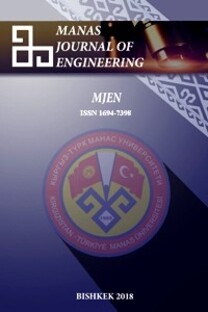ULEKSİTİN SO2 İLE DOYURULMUŞ SULARDA ÇÖZÜNMESİNDEN ELDE EDİLEN SÜSPANSİYONLARIN ÇAPRAZ-AKIŞ MİKROFİLİTRASYONU
Bu çalışmada uleksitin SO2 ile doyurulmuş sularda 92oC de çözündürülmesi sonucu elde edilen CaSO3 ve MgSO3 süspansiyonlarının mikrofiltrasyonu boyunca, transmembran basıncı, çapraz akış hızı ve membran por boyutlarının süzme özellikleri üzerindeki etkileri belirlenmiştir. Sızıntı akışı, 150-400 kPa transmembran basıncında, 3,8-8,3 L.dakika-1 çapraz akış hızında ve çeşitli por boyutlarına sahip membranlar kullanılarak ölçülmüştür. Partikül konsantrasyonu 22,9 g.L-1, sıcaklık 30oC ve pH 7,33’te sabit tutulmuştur. Akıların ve spesifik kek dirençlerinin tansmembran basıncının ve çapraz akış hızının artması ile arttığı tespit edilmiştir. Keza, akı, membran por boyutlarından çok fazla etkilenmemiş, spesifik kek dirençleri de düzenli bir dağılım göstermemiştir. İlaveten kekin sıkıştırılabilir bir kek olduğu bulunmuştur
Anahtar Kelimeler:
Uleksit, Çapraz-akış süzme, SO2, CaSO3
CROSS-FLOW MICROFILTRATION OF SUSPENSIONS OBTAINED BY DISSOLVING ULEXITE IN SO2 SATURATED WATER
In this study, the effect of the transmembrane pressure, cross-flow rate and membrane pore sizes on the filtration properties have been investigated during the microfiltration of suspensions containing CaSO3 and MgSO3 from dissolving of ulexite in SO-saturated water at 92oC. Permeate has been measured at 3.8-8.3 LPM cross-flow rate and 150-400 kPa transmembrane pressure by using membranes with various pore size. Particle concentration has been kept constant at 22.9 g.mL-1, temperature at 30oC and pH at 7.33. As result, it has been determined that specific cake resistance increases by increasing transmembrane pressure and cross-flow rate, and also, permeate rate increases with increasing transmembrane pressure and cross-flow rate. In has been seen that specific cake resistances and permeate rates do not change with membrane type and pore size. In addition it has been found the cake can be compact
Keywords:
Ulexite, cross-flow filtration, SO2, CaSO3,
___
- Sınırkaya M., Kocakerim MM., Boncukçuoğlu R, et al. Recovery of Boron from Tincal Wastes. Ind. Eng. Chem. Res. 44, 427-433, 2005.
- Emir B.D. Tinkal konsantresinden borik asit ve sodyum sülfat üretimi. Doktora Tezi. İTÜ Kimya Fakültesi, İstanbul, 1979.
- Ould-Dris A, Jaffrin M.Y., Si-Hassen D, et al. Analysis of cake build-up and removal in cross-flow microfiltration of CaCO3 suspension under varying condition, Journal of Membran Science 175, 267-283, 2000.
- Wiesner MR, Clark MM. Members Associate, ASCE, and Mallevialle, J. Membrane Filtration of Coagulated Suspensions. Env. Eng. Sci., 115, pp. 20-40, 1939.
- Fradin B, Field RW. Crossflow microfiltration of magnesium hydroxide suspensions: determination of critical fluxes, mesurement and modelling of fouling. Seperation and Purification Technology 16, 25-45, 1999.
- Yıldız E, Pekdemir T, Keskinler B, et al. Surfactant-Enhanced Crossflow Filtration in Nitrate Removal from Water. Institution of Chemical Engineering, 74(A), pp. 546-553, 1996.
- Akay G, Keskinler B, Çakıcı A. Et al. 1998. Phosphate Removal From Water by Red Mud Using Crossflow Microfiltration. Wat. Res. 32(3), pp. 717-726, 1998.
- Vyas HK, Mawson AJ, Bennett RJ, Marshall AD. A new method for estimating cake height and porosity during crossdlow filtration of particulate suspensions. Journal of Membran Science, 176, 113-119, 2000.
- Frey JM, Schmitz P. Particle transport and capture at the membrane surface in cross-flow microfiltration. Chemical Engineering Science, 55, 4053-4065, 2000.
- Cumming IW, Holdich RG, Ismail B. Prediction of deposit dept and transmembrane pressure during crossflow filtration. Journal of Membran Science, 154, 229-237, 1999.
- Song, L. Flux decline in crossflow microfiltration and ultrafiltration: mechanisims and modeling of membran fouling. Journal of Membran Science, 139, 183-200, 1998.
- Wang L, Song L. Flux decline in crossflow microfiltration and ultrafiltration: experimental verification of fouling dynamics. Journal of Membran Science, 160, 41-50, 1999.
- Connell H, Zhu J, Bassi A. Effect of particle shape on crossflow filtration flux. Journal of Membran Science, 153, 121-139, 1999.
- ISSN: 1694-7398
- Yayın Aralığı: 2
- Başlangıç: 2001
- Yayıncı: KIRGIZİSTAN-TÜRKİYE MANAS ÜNİVERSİTESİ
Sayıdaki Diğer Makaleler
ZEMİN KÜTLE ÖZELLİKLERİNİN BELİRLENMESİ ÜZERİNE DENEYSEL BİR ÇALIŞMA
